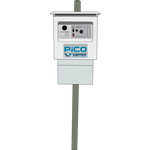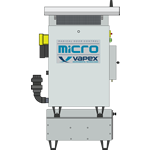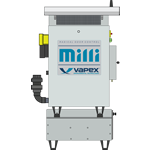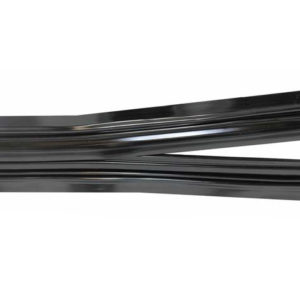Problem:
The Harrison Wastewater Treatment Plant is a 2.3 MGD average daily design flow wastewater plant servicing the City of Harrison in Southwest Ohio. During the pilot testing, the plant was receiving an average daily flow of approximately 1.1 MGD. Due to local industries and residential waste, the influent wastewater to the Harrison plant occasionally experiences a high fat, oil, and grease (FOG) load. This can lead to a surface accumulation of approximately one foot in the 31’L × 8’W × 30’D influent well which is removed monthly to reduce the interference the FOG buildup creates with existing machinery and float switches.
Solution:
Vapex Environmental Technologies and its licensee, with the permission of the City and in cooperation with the City’s engineer tested the Vapex odor control technology at the plant for two weeks in May 2011. The system demonstrated it was useful in reducing FOG build up without the addition of chemicals eliminating the need to remove surface build up monthly. The tests also showed that the fats, oils, and grease did not congeal downstream and did not affect downstream process in the oxidation ditch plant.
Story:
Currently, raw wastewater influent goes into an Influent Pump Station (IPS) wet well as it enters the plant. From the wet well, the wastewater proceeds to the vortex grit removal handlers and then to a dedicated Grease Removal Tank (GRT). The GRT utilizes air floatation of grease but is anticipated for upgrade to accommodate the increased FOG loading to the plant. Essentially, the wet well is performing the function of a grease trap where the FOG buildup can be observed collecting within a day of removing the grease and cleaning the well. Plant personnel state, on average, that a foot of FOG buildup occurs every 4 to 6 weeks. The current practice is to remove the FOG using a vacuum truck monthly.
Pilot Test:
Influent and effluent grease concentrations were recorded weekly in April and daily from May 3rd thru May 8th and on May 10th. Composite influent samples were taken from a manhole directly upstream of the wet well and composite effluent samples were taken directly after the wet well in the screenings building. Taking composite samples as opposed to grab samples yielded a higher degree of accuracy for calculating the amount of FOG that would remain in the well. Samples were taken by plant personnel per standard sampling procedures and the analysis was conducted by an independent laboratory. Please refer to Table 1 and Table 2 for a summary of the results.
The total amount of FOG retained in the IPS wet well during the 8‐day pilot test was approximately 2,990 lbs (Table 2). This amounts to 53 cubic feet of FOG (assuming a density of 56.4 lb/cu.ft.) that entered the well and should have accumulated on the surface had the Vapex technology not been utilized. FOG totals were calculated based on composite samples over the course of 24 hours and also by the influent flow totals that were recorded by the plant.
Table 3 lists additional data for the daily flows and characteristics received by the plant during Phase 1.
It can be stated with a high degree of confidence that during the May trial the FOG concentration entering the well was greater than in April. On May 5th, the FOG concentration was high and it is known that this level occurs sporadically. However, even with higher FOG levels entering the well, Vapex PLC‐3500 was able to oxidize the FOG and may be useful in preventing further buildup. The influent flow information obtained from the monthly operating reports for April was used to calculate FOG retained in the wet well.
It is important to note that plant effluent concentrations of FOG remained “Not Detectable” (ND) before and after the pilot test began, which is clearly evident from the fat concentration averages in April (before Vapex) and in May (during Vapex use). Thus, the data substantiate the fact that the Vapex is oxidizing the lipids within the wet well and not creating an emulsion therefore, not altering downstream process conditions.
FOG Composition Analysis
FOG composition was analyzed two times during the pilot test by an independent laboratory. Under the supervision of plant personnel, the samples were taken from the surface of the grease layer that was in direct contact with the Vapex treatment. The results show a significant decrease in the amount of fat present in the well. Lower levels of FOG also correspond to lower amounts of volatiles and floatable (non oxidizable) materials since there is less grease to buoy those to the surface of the water. However, a small percentage of these items will invariably continue to collect in the well.
Figure 1 and Figure 2 show sample composition before and during the trial, respectively. Total Fat was 49.2% of the sample collected prior to starting the test. Four days after energizing the Vapex unit, a second sample was collected at the same location and the Total Fat decreased to 3.7% of the sample. This was a 92.5% decrease in Fat confirming Vapex is oxidizing the surface Fats, Oils, and Grease.
FOG Measurement:
Phase 1
A photographic log of the progress of the grease reduction was recorded. Plant personnel estimated from visual observations that the majority of the grease layer was between 5 and 10 inches.
The FOG‐water border line is evident in Day 1 before the Vapex unit was installed. The same border does not substantially move in the pictures of Day 5 and Day 11, although, 2,990 lbs of FOG entered and retained in the influent well. This estimate does not include floatables and volatiles that add to the FOG layer. Fifty three cubic feet (53 ft3) of grease, or a 2.56 inch thick layer on the entire surface of the process water, entered the well. This volume of FOG only accounts for 50% of the surface build up. By decreasing the FOG that holds the floatables together the total amount of build up was drastically reduced. Furthermore, the sample taken prior to the trial was solid and very dense. Once the Vapex unit was energized the sample was in the process of being liquefied and less dense. Harrison plant operators have historically observed FOG overtake the entire well in a very short time. Yet, even after 11 days, we can see that the FOG boundary has not advanced any further in the well. This is strong evidence to claim that the Vapex technology has prevented any further FOG from accumulating in the influent well.
Figure 3 is a picture that was taken 7 to 14 days after the well was cleaned. Notice the natural progression of FOG buildup without Vapex use. Not only is no process water visible, the FOG looks clumpy and dense. Compare that picture with the pictures (See Figure 4) taken during the trial and the process water is visible and the FOG layer does not seem dense. The fact that the FOG line did not move over the course of 11 days is significant evidence that additional FOG buildup was prevented. The turbulence of the influent water entering the well is not a factor in the center of the well, since it is clear that it historically does not stop FOG from completely covering the center areas of the well. Furthermore, no changes were made to the influent water entering the well, thus there should be no increase or decrease in the turbulence of the incoming flow.
Phase 2
Phase 2 commenced on May 12th, 2011, and continued until May 20th, 2011. During this phase of the pilot, a record of representative photographs was taken to form the basis of the data collection. These photographs were then compared to photographs taken April 6th, 2011, which was exactly 5 days after the April 1st, 2011 cleaning of the influent well. This provided a baseline measurement to compare the FOG accumulation 5 days after cleaning the well, both with and without the Vapex unit energized. Refer to Figure 5 and Figure 6 below.
The estimated thickness of the FOG at the April 6th baseline was between 2 to 3 inches while the May 20th buildup was estimated at less than three‐quarters of an inch (< 3/4”) and the sample was liquid. A small amount of build up will always remain due to the rate of FOG entering the well along with the floatables and volatiles. But, as proven by the trial, Vapex can effectively oxidize surface FOG at the average rate of 427 lbs/day with spikes over 1,100 lbs/day.
For the trial, the nozzles were aimed at the wall closest to the ladder (the direction of flow) where FOG would start to collect and buildup. Consequently, the nozzle configuration was not optimal for this application and can be improved to obtain maximum coverage and effectiveness. In addition, only four nozzles were used during the trial where in actual implementation five nozzles would be highly recommended with nozzles placed at different locations to provide sufficient coverage.
Conclusions:
Fats entered the well at an average rate of 427 lbs per day, or 7.6 cubic feet per day with a spike of over 1,100 lbs per day during Phase 1 of the trial while the FOG content in the process water leaving the wet well remained unchanged and undetectable once the trial commenced and continued throughout the entire trial. Harrison plant personnel confirmed that the surface buildup would have eventually covered the entire wet well surface if the Vapex unit was not in operation. From independent laboratory analyses, surface buildup samples were compared before and after Vapex use and there was a 92.5% reduction in Total Fat. On a microscopic scale, this is consistent with Vapex’s ability to oxidize and break down fats, oils, and grease while not affecting downstream processes in the plant.
Vapex technology proved that it can oxidize fats, oils, and grease, even at the extremely elevated FOG concentrations levels experienced by the City of Harrison WWTP. The trial was successful in demonstrating, visually and objectively, that it can drastically reduce the surface collection of FOG. Furthermore, it can oxidize hydrogen sulfide, mercaptans, and other odorous compounds at the wet well therefore reducing odors in the well and surrounding areas. Finally, since the Vapex oxidizes fats, oils, and grease, there appeared to be is no negative effect on downstream plant operations.




